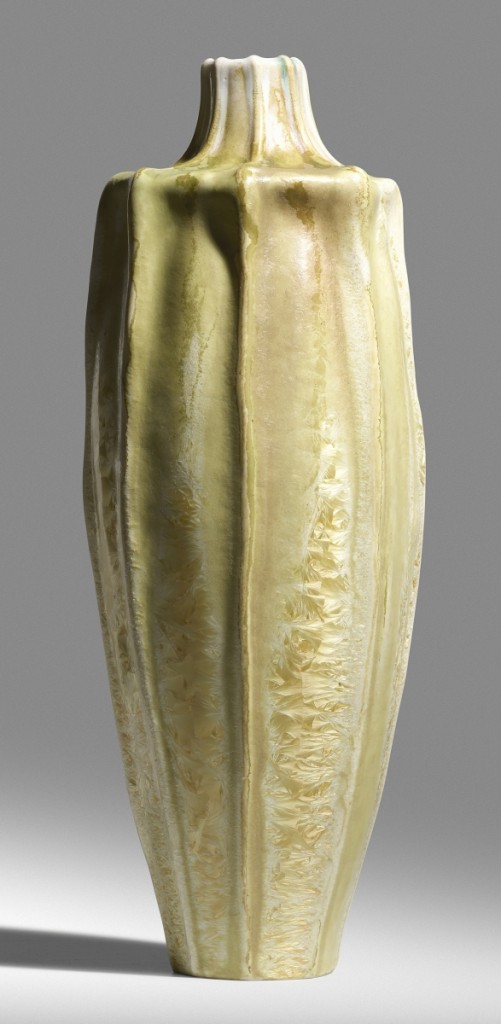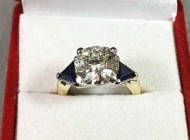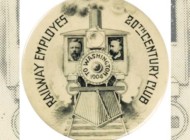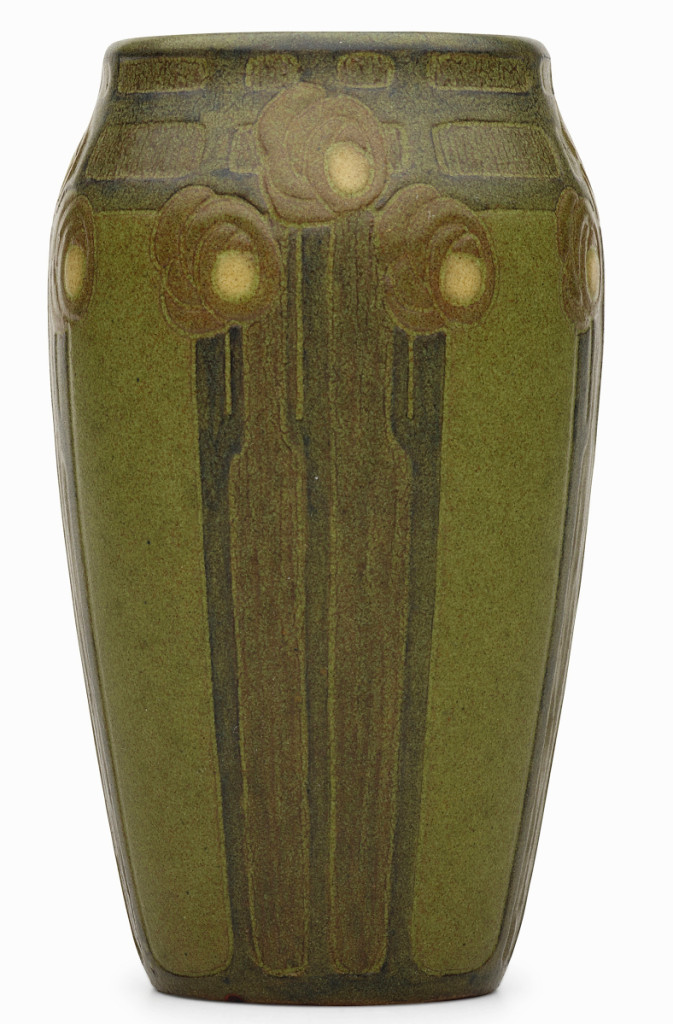
Top lot in the sale was this rare Marblehead vase, circa 1910, selling for $150,000 against an expectation of $25/35,000. Crafted by Arthur Hennessey and Sarah Tutt for Marblehead Pottery, the glazed earthenware piece, 6¾ inches high by 4 inches in diameter, is one of very few known examples of this form, one of which is in the permanent collection of the Newark Museum, Newark, N.J. Rago said the price was a record for the form.
Review by W.A. Demers, Photos Courtesy of Rago/Wright
LAMBERTVILLE, N.J. – A rare Marblehead vase, circa 1910, was the runaway star in Rago’s American art pottery auction on June 20, selling for $150,000 against an expectation of $25/35,000. Crafted by Arthur Hennessey and Sarah Tutt for Marblehead Pottery, the glazed earthenware piece, 6¾ inches high by 4 inches in diameter, is one of very few known examples of this form, one of which is in the permanent collection of the Newark Museum, Newark, N.J.
The work features crisp, deeply carved conventionalized flowers, an impressed manufacturer’s mark to underside “MP” with ship symbol and incised with a signature to underside “HT.”
“Skinner sold a piece for about $300,000 so this is at best the second highest price for Marblehead,” Rago co-principal David Rago told Antiques and The Arts Weekly. He said there were four bidders on the phone and one in the room, and that the vase went to a private collector.
Of the four or five known examples, “this was a particularly strong example,” said Rago, “in perfect condition, precisely fired, and with more than the usual amount of modeling of the design. They can be relatively flat, and the gentle incising and tooling really helps bring out the nuances of the design. I have sold two more of these at auction, about $130,000 all in. The price is definitely a record for the form.”
Rago characterized the overall sale as a “barn-burner” and it was. With the total exceeding $1.3 million, more than one and half times the low estimate and a 90 percent sell-through rate, the auction clearly illustrated the strength of the market, said Rago. The roughly 200-lot sale featuring designs by many of the masters in the field, was the first auction dedicated solely to the material since the firm auctioned the Berberian collection in 1994. The auction included works by Adelaide Robineau, Taxile Doat for University City, Arthur Hennessy and Sarah Tutt for Marblehead Pottery, Frederick Hurten Rhead and many more.
A rare tall gourd form by Taxile Doat for University City brought $81,250. Created in 1914, the celadon and ivory crystalline glazed porcelain vessel, 10¼ inches high, carried a glazed signature and date to underside “UC 1914 TD.” It came from a private California collection.
Poised for a leap to $47,500 was a rare centerpiece by Adelaide Robineau featuring five large and 19 small hand carved frogs. The 1926 glazed porcelain piece, 3½ by 13 inches in diameter, had carved signature and date to underside “AR 1926” and exemplified the exceptional detail of Robineau’s best work.
Exuberant Teco Pottery form was represented in the sale by an innovative low-fired example by Fritz Albert (1865-1940). Fetching $43,750, the circa 1905 model 310 stood 18 inches high and was impressed with manufacturer’s mark and model number to underside “Teco 310.”
The auction also included a run of pieces by the quirky “Mad Potter of Biloxi” George Ohr, whose works are entirely original and technical tours-de-force that were well ahead of their time. Appreciation continues to grow for Ohr’s shaped and misshaped, unique and exquisite forms in a variety of bold glazes. All 28 lots by Ohr sold for $416,937 nearly double the low estimate for the group. The top selling piece, at $62,500, was a large vase, 1897-1900, 5½ inches high by 6½ inches wide, featuring Ohr’s trademark in-body manipulations and sporting green, gunmetal and raspberry glazes with a yellow interior. An impressed signature to the underside was “G.E. Ohr Biloxi, Miss.”
Other Ohr highlights included an exceptional large coupe, 1897-1900, with an in-body twist, ruffled rim, dimples and a vivid indigo glaze, which resulted in $37,500; another large coupe at $27,500, a circa 1900 piece with two ear-shaped handles and a speckled and striated brown, green and ochre glaze; and a large pitcher, 1897-1900, which at an oversize 5 by 7¾ by 5 inches featured a cut-out handle and an ochre, green, raspberry and gunmetal glaze. It finished at $35,000, more than twice its high estimate.
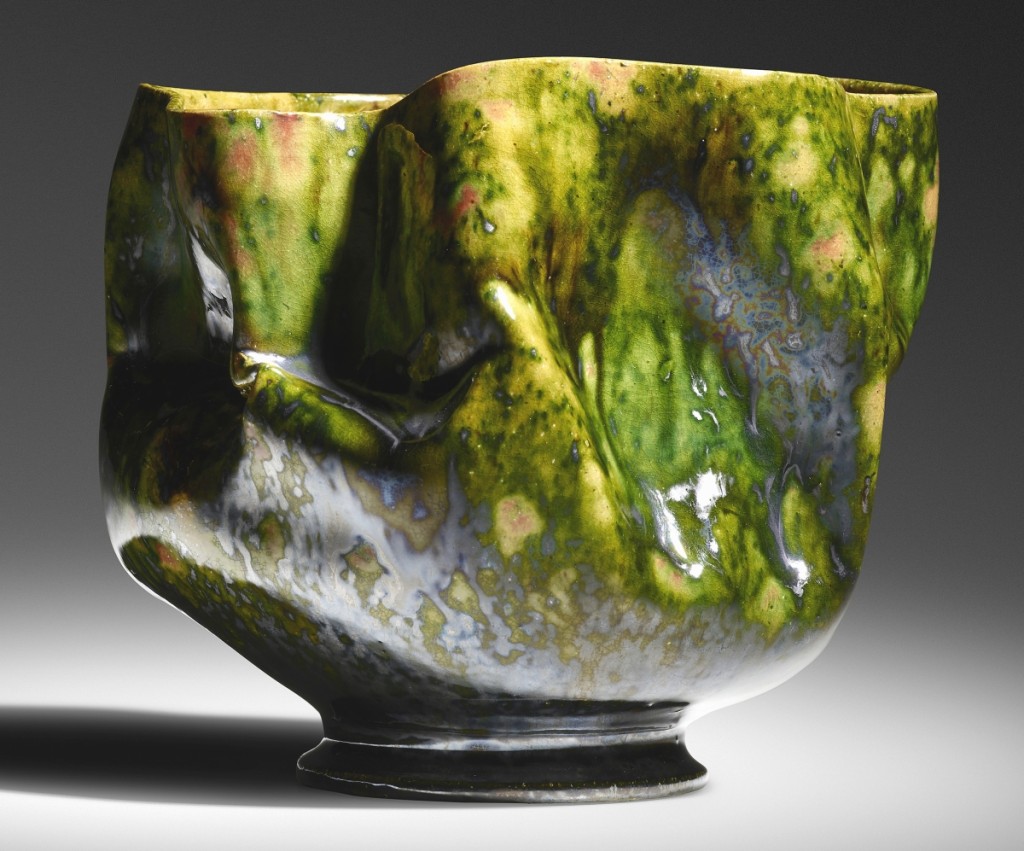
From an extensive run of pieces by the “Mad Potter of Biloxi” George Ohr, the top selling piece, at $62,500, went to this large vase, 1897-1900, 5½ inches high by 6½ inches wide, featuring Ohr’s trademark in-body manipulations and sporting green, gunmetal and raspberry glazes with a yellow interior.
The sale presented more than iconic vessels. Bid to $24,700 was an Arthur Baggs for Marblehead Pottery scenic tile, circa 1908, 6 inches square, impressed with manufacturer’s mark to underside ‘MP’ with ship symbol. It came from the collection of the artists, by descent. Also by Baggs and from his collection was a Marblehead Pottery rare frieze comprising of five tiles depicting stylized oak trees. Each tile measured 6 square inches and the frieze stretched to 33¼ inches. An original paper label to verso read “No D – 61 Des. by A.E. Baggs $15.00.” Here it commanded $12,350.
Grueby is a staple of these sales and was represented by a couple of standout pieces. One by Marie Seaman for Grueby Faience Company, a rare vase with cinquefoils, circa 1905, took $24,700, while a statuesque Grueby Faience Company vase with irises, 1898-1910, 11¾ inches high, rose to $21,250.
Punctuating the reascendance of Arts and Crafts sensibilities – “Reports of the death of the Arts and Crafts market have been greatly exaggerated,” quipped Rago – a Kataro Shirayamadani for Rookwood Pottery modeled matte vase with geese, 1901, 10½ inches high, brought $16,250 against its $3/4,000 estimate. It was exhibited in “The Arts and Crafts Movement in America 1876-1916,” in 1972 at Princeton University Art Museum, then traveled to the Art Institute of Chicago and the Renwick Gallery of the National Collection of Fine Arts, Smithsonian Institution.
David Rago and Suzanne Perrault auctioneered the sale with a small audience in attendance for the first time since the start of the pandemic. Interest throughout the auction was strong; besides the few floor bidders, participants bid live by telephone or online using our platform or those of third-party partners.
Prices reported include the buyer’s premium as stated by the auction house. For information, www.ragoarts.com.

